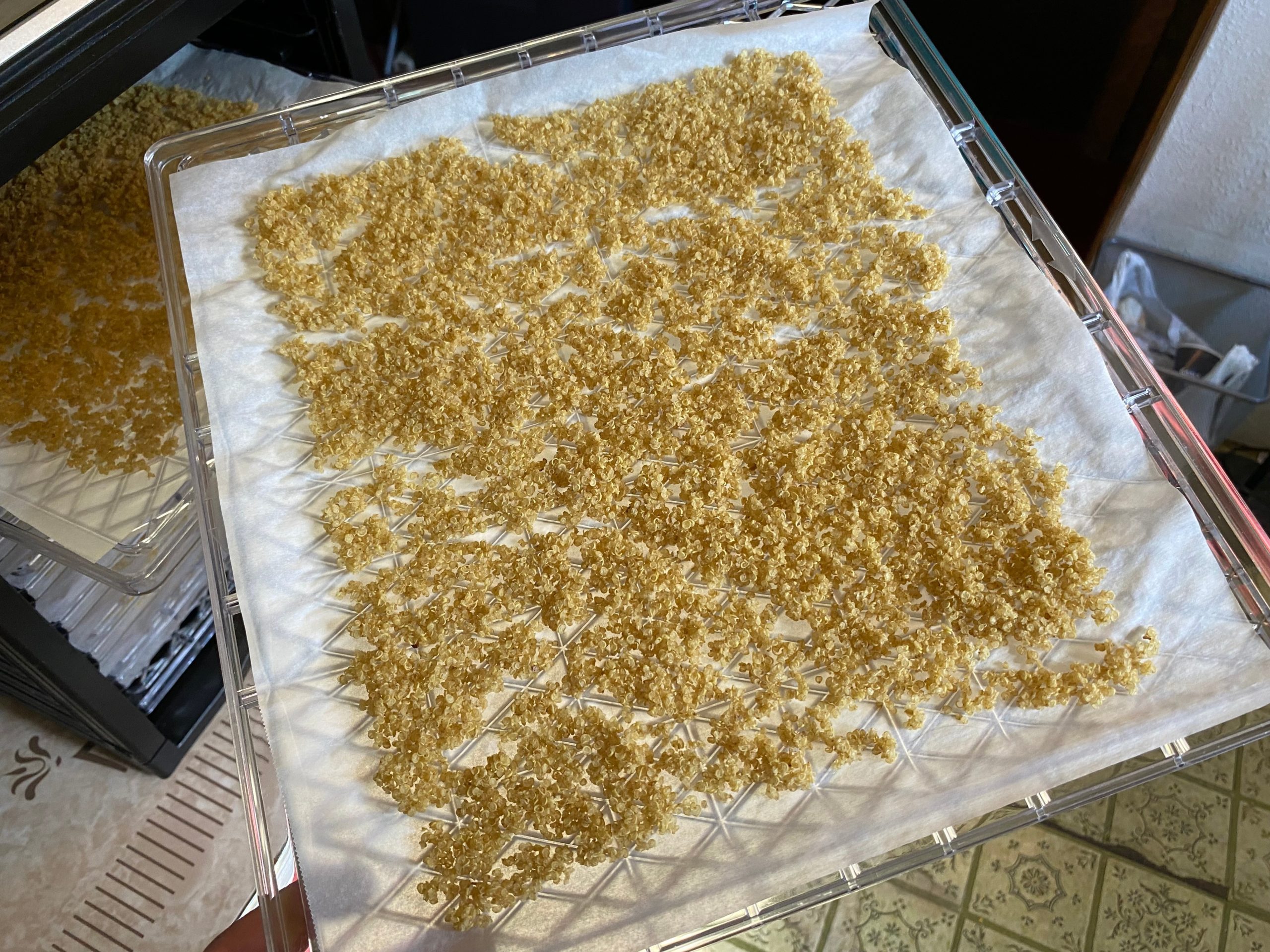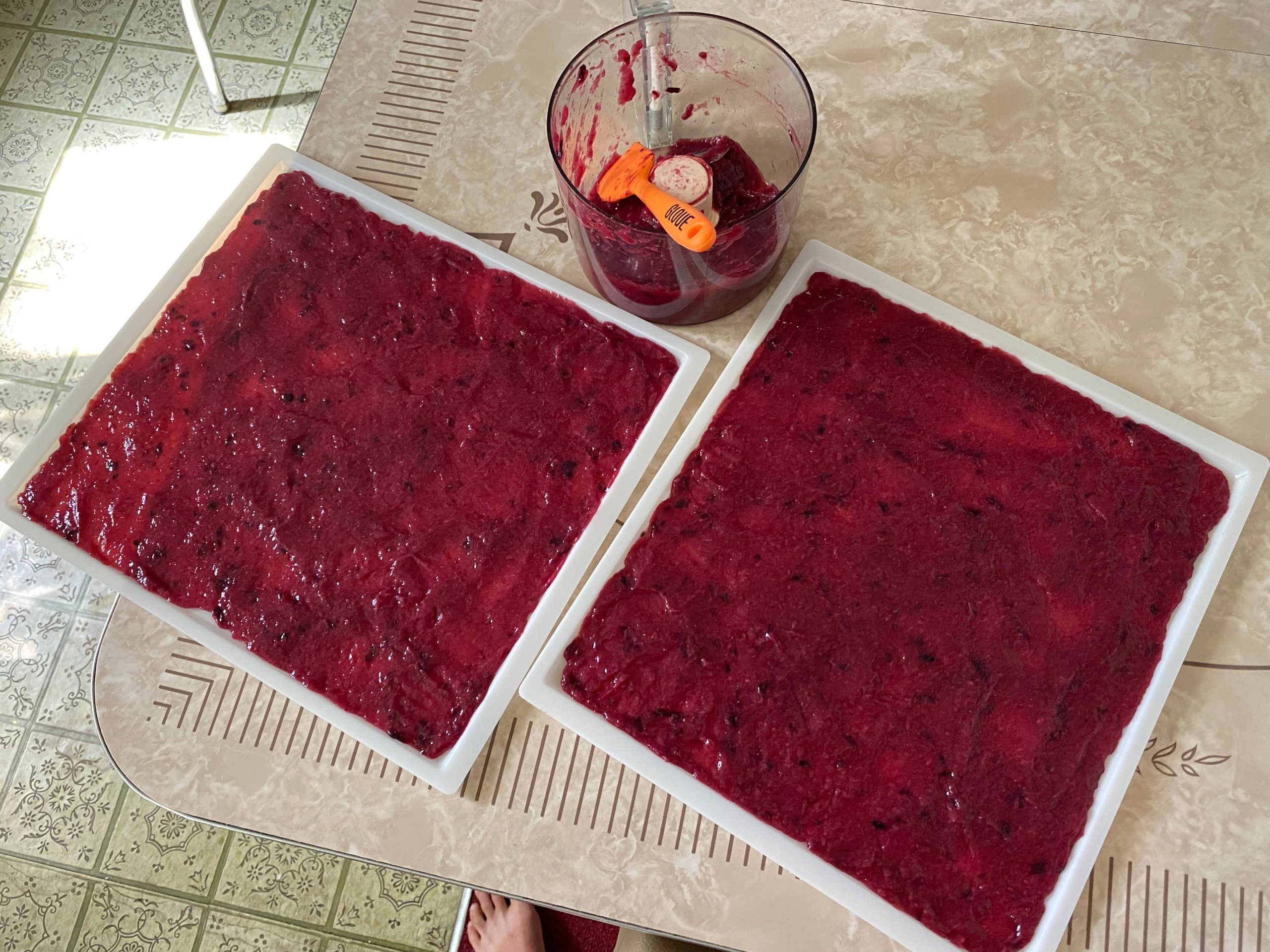Meal Preparation
I enjoy creating and assembling backpacking meals. It is somewhat of a necessity since I am vegetarian, gluten-free, and enjoy consuming nutritional meals on the trail. Coupled with that is planning, as a long trail means either food drops or resupplies in towns. So far I prefer the food drop approach.
Advance Preparation
Most of my lunch options use quinoa as the base. It easily replaces couscous in any recipe once it has been dehydrated. I cook a large batch of quinoa (four cups of grain, eight cups of water) and let it cool. Then I spread it over nine dehydrator trays lined with parchment paper to prevent the small grains from falling through. It takes 10 hours at 131°F. Once dry, the quinoa breaks into smaller clumps for easy bagging. The grain is easily re-hydrated with 30 minutes of cold soaking.
A few weeks ago, I made fruit leather for the first time. I followed a recipe with equal amounts of fresh fruit and SCOBY. SCOBY stands for “symbiotic colony of bacteria and yeast” and is the mother or starter in a batch of kombucha. Since I brew kombucha, I was looking for a way to use retired SCOBY moms. I dehydrated the fruit leather at the lowest temperature possible to retain the probiotic content of the SCOBY. It turned out great, easily peeled off the trays, and tasted delicious. Look forward to sharing it as a snack on this coming trip!
South Dakota Centennial Trail
The Centennial Trail is 123 miles long, traversing the Black Hills from north to south. Three friends and I are hiking the trail, aiming to complete it in 10 days, which means a 12 mile average daily distance. On prior trips of a similar pace, it worked well for me to eat breakfast, lunch, an afternoon snack, dinner, and the occasional dessert.
Breakfast
I enjoy a hot breakfast as it can be chilly in the morning. My standard is instant oats mixed with pea protein powder and dried fruit. Adding fat is also key or my energy level will ebb over the course of the morning. However, in the past, I struggled with this aspect. I added peanut butter or coconut oil, both of which are messy in bulk so individual packets were easier, but it is a lot of packaging. I became very plastic conscious this past year. For this trip, I added butter powder and will see how I like it.
Lunch
All my lunches are cold soak style. Eight of them have a quinoa base with lentils, garbanzos, or cashews added for protein and spices for flavor. Each contains coconut oil since I had some of the Trader Joe packets left over from last season. I’m trying something different for the other two lunches. Dehydrated pinto beans and hummus mix with corn chip dippers. I packed a small bottle of olive oil to use for the two dips as well as all my dinners. Curious to see how the bottle works, I will attempt to keep it upright but bag it in case of leakage.
Dinner
On the Colorado Trail, I rotated three dinners. In the end, I liked two of them. One was taco shells with beans, nutritional yeast, and avocado. For that trip, I dehydrated avocado slices (actually worked well) but didn’t get around to it this time so I’ll carry a whole avocado. The other meal I liked was peanut noodles made with brown rice ramen. In order to expand my dinner repertoire beyond two meals, I am trying a whole range of noodle flavor variations on this trip. The flavors are garlic parmesan, lemon butter, pasta primavera, spicy cashew, mushroom & TVP, and tomato pesto. Hopefully, at least a couple will become new favorites.
Snacks & Dessert
The snacks vary from trip to trip. My sister is on this trip so I am sure she will bring a fabulous dessert! I packed a Trailside Tiramisu, recipe courtesy of Backcountry Foodie (https://backcountryfoodie.com/).
This website contains affiliate links, which means The Trek may receive a percentage of any product or service you purchase using the links in the articles or advertisements. The buyer pays the same price as they would otherwise, and your purchase helps to support The Trek's ongoing goal to serve you quality backpacking advice and information. Thanks for your support!
To learn more, please visit the About This Site page.

 ">
">





Comments 6
Thanks for the shout out, Emily! Hope you enjoy our Backcountry Foodie recipes on your upcoming trips. Happy trails!
While not strictly vegan, i tend to eschew most animal products, most of the time, so i appreciate articles like this. Always good to see how folks work out animal-free food options on the trail.
I’ve dehydrated other foods, but would not have thought to cook and dehydrate quinoa. Will have to try that when/if i have time.
Similar to fruit leather, tomato paste can be dried on a (lightly oiled) baking sheet in an oven on the lowest temperature setting, in lieu of a bona fide dehydrator contraption. Just leave the door slightly cracked (wooden spoon handle works) so moisture can escape, and maybe use two pans so the metal under the paste doesn’t get too hot. Bits of tomato leather can be added to soups or other meals to augment the flavor.
Speaking of quinoa, i recently came across quinoa flakes (who knew?), which reconstitute almost immediately in water. I mix some in with instant oats for morning oatmeal, just to diversify my grain intake. Favorite ways to jazz up oatmeal include dried apples, cinnamon and nutmeg, touch of molasses powder, some dried coconut powder. A bit of date sugar (ground up, dried dates) sprinkled on top adds some gentle sweetness.
Happy eating!
Thanks for the tip about tomato leather. I also did not know that quinoa flakes were an option. They sound great for breakfast.